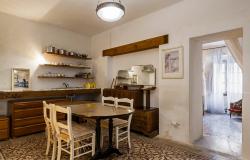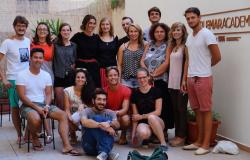Words by Pat Eggleton
If the “fico d’India” or prickly pear is ubiquitous in Sicily, it is particularly so in the area around Militello in Val di Catania: as you approach the town, which lies in the Catania Valley near the pottery town of Caltagirone, bushes of fichi d’India surround you and the ripe fruits cover the winding road and fields as you pass.
The Festa del Fico D’India e della Mostarda at Militello in Val di Catania, inaugurated in 1987, takes place over the second weekend of October every year but the culmination is always the Sunday when, in addition to the stalls, music and tastings, there are troops of flag wavers, bands and a parade of Sicilian carts.
This year I decided to go and see the Festa for myself. Arriving at the top of one of Militello’s steep streets at around 11 am, as I looked down towards the centre I could see the canopies of hundreds of stalls and my first thought was, “This is for me!” Like the Italians, I love bancarelle [market stalls] and, even from a distance, I could see that these were special.
 As I perused the stalls the atmosphere was festive and I soon bumped into some people I knew from Modica. The whole population of south-east Sicily, it seemed, had headed for Militello last Sunday! What was on sale? Crates, bags and truck-loads of fichi d’India, as you would expect, but also olives, biscuits, ceramics, plants and even furniture. [I might have bought a settee if my friend could have got it in his car!] There were also CDs, souvenirs, clothes and candles made in the form of prickly pears. There were tastings of some divine honey and I could not resist a jar of bright golden “miele di mandarino”.
As I perused the stalls the atmosphere was festive and I soon bumped into some people I knew from Modica. The whole population of south-east Sicily, it seemed, had headed for Militello last Sunday! What was on sale? Crates, bags and truck-loads of fichi d’India, as you would expect, but also olives, biscuits, ceramics, plants and even furniture. [I might have bought a settee if my friend could have got it in his car!] There were also CDs, souvenirs, clothes and candles made in the form of prickly pears. There were tastings of some divine honey and I could not resist a jar of bright golden “miele di mandarino”.
 As this was also billed the “festa della mostarda” there was plenty of this black, leathery substance on sale too, some so freshly made that it was still warm. This is not the famous “mostarda di Cremona”, which consists of preserved fruits with a mustard flavour, nor is it “mustard” as we know it in the US and UK: Sicilian “mostarda” is a solid preserve made from grape must and wood ashes. Yes, ashes, but don’t worry - they are filtered out. The reason for its name is that the Romans used to mix mustard seeds with verjuice instead of vinegar and in the Middle Ages, for a time, the vinegar was replaced by must, so some etymological confusion arose. This “mostarda” is too leathery for my taste but I enjoyed looking at the perfectly moulded forms and watching other people taste it.
As this was also billed the “festa della mostarda” there was plenty of this black, leathery substance on sale too, some so freshly made that it was still warm. This is not the famous “mostarda di Cremona”, which consists of preserved fruits with a mustard flavour, nor is it “mustard” as we know it in the US and UK: Sicilian “mostarda” is a solid preserve made from grape must and wood ashes. Yes, ashes, but don’t worry - they are filtered out. The reason for its name is that the Romans used to mix mustard seeds with verjuice instead of vinegar and in the Middle Ages, for a time, the vinegar was replaced by must, so some etymological confusion arose. This “mostarda” is too leathery for my taste but I enjoyed looking at the perfectly moulded forms and watching other people taste it.
Just before midday everybody seemed to be moving towards the Town Hall so we followed the crowd and were delighted as band after band, all smartly uniformed, marched into the square and played lively versions of some Italian classics. All were enthusiastically applauded but the biggest round was reserved for the Band of the Bersaglieri, the Italian Army’s crack troops who run everywhere. They were an impressive sight, in army fatigues with their traditional, black–plumed hats and, as they ran into the square playing a loud, trumpet fanfare, the crowd went wild.
 Then it was time for the procession to arrive in the square. Of course, there was a medieval prince with his princess and, following them, at last, the highlight of the day’s events: a parade of at least twenty beautifully preserved, traditional Sicilian carts with their magnificent horses looking particularly happy because today they were “all dressed up with somewhere to go”. Atop each cart was a little band playing traditional instruments and the crowd clapped to their rhythm as the horses trotted daintily into the square. I had never seen so many Sicilian carts at once!
Then it was time for the procession to arrive in the square. Of course, there was a medieval prince with his princess and, following them, at last, the highlight of the day’s events: a parade of at least twenty beautifully preserved, traditional Sicilian carts with their magnificent horses looking particularly happy because today they were “all dressed up with somewhere to go”. Atop each cart was a little band playing traditional instruments and the crowd clapped to their rhythm as the horses trotted daintily into the square. I had never seen so many Sicilian carts at once!
All of Militello’s restaurants being solidly booked for lunch, we left at 1pm and headed for Caltagirone but we could see that the festivities were going to continue well into the afternoon and evening. I would like to say thank you, here, to the good folk of Militello in Val di Catania, for they certainly know how to hold a festa!
Other events in Sicily.
Find accommodation in the Catania province.












